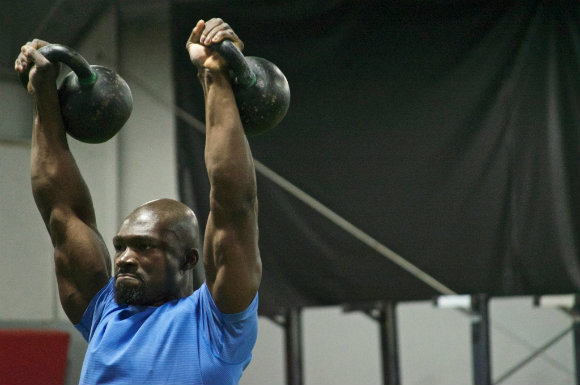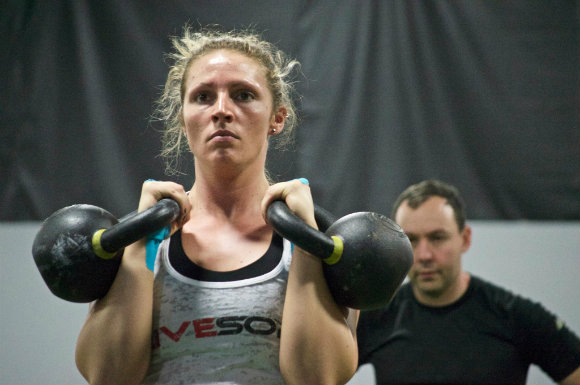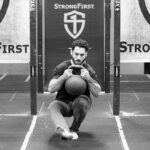The push press is a bit like the clean. The clean gets neglected because the swing and snatch are “so much cooler.” The push press seems to be often thought of as “that thing you do on the way to learning the jerk.” But there are some ninja secrets contained in the push press that make it superior to the jerk for my clients—and probably yours, too.
Why Are We Talking About the Push Press?
Because we love to stick heavy metal over our heads. And, who doesn’t want shoulders that, as the CEO has said, “can give and take punishment”? Not only this, but the push press helps us to develop some serious core strength because we now have to stabilize some hefty double kettlebell iron in the lockout position.
While the double kettlebell jerk allows you to put the heaviest amount of weight overhead, the push press is quicker to teach and learn. And while it does have a reasonably high demand on thoracic mobility, it’s not the same high demand as the jerk (because we catch the jerk in the drop position, it requires greater t-spine and shoulder mobility). This opens up the range of people whom we can offer this training to, and it reduces the amount of corrective work required to get people to the point where they can take advantage of this exercise.
I work with a lot of athletes who are competing in obstacle course races. Often, obstacle course racers train in teams and we have to coach to the level of the least skilled. The push press allows us to do that, and if we include the single kettlebell push press as a regression, then the mobility requirement drops compared to the double. So if you are teaching group classes, the push press is a tool you need to have in your arsenal.
The Push Press for Sporting Attributes
The push press has a greater correlation to increasing jump mechanics than the jerk. So much so, that many English soccer teams have started to use the barbell push press as a training method for increasing vertical jump height (a sought-after attribute in soccer for head-butting and blocking the ball). In obstacle course racing there is also a large requirement for vertical jumping, be it to clear fire-pits, logs, fallen comrades, etc.
Many other sports also contain a requirement for either vertical jumping or the rapid creation of force from the legs that is then expressed, via the trunk, through the arms. MMA, Judo, badminton, and basketball are just a few of the sports that could benefit from the use of the push press in the weight room.
The double kettlebell push press is a better training tool than the barbell push press because we don’t have the problem of our face getting in the bar’s way. This keeps the movement more in tune with the vertical jump mechanic. The push press is superior here to the jerk because we don’t have to anticipate the third phase of the movement (the drop), we can put the entirety of our focus into the drive phase, which is where we get the bulk of our carryover to the vertical jump.
Pull the trigger and BANG! Once you initiate that dip, you are committing to pulling the trigger on your drive. This helps develop confidence and is also a nice, safe way of developing your trigger for explosive movements (alongside your heavy swing training).
Demonstrating the flow of the push press into the pull-up.
The Push Press in an Obstacle Course Environment
Coming back to obstacle course racing, there is zero chance of someone performing a dead-hang pull-up in an obstacle course race. The only reason we have dead-hang pull-ups in obstacle course training is for healthy development through the full range of motion of the shoulder. This creates a buffer capacity in case things go wrong and the psychological benefit of knowing that once you get your hands on an obstacle you are getting yourself over it.
Any actual climbing over a wall is a hybrid movement consisting of a vertical jump (push press) or horizontal jump (swing), a partial pull-up, and a wall assisted climb (vertical crawl). The bottom half of the pull-up seems to be the sticking point for many of my female racers, so we can avoid this part of the pull-up completely by training to jump through it (that said, you should still all learn how to do a full pull-up).
In addition, there can’t really be enough said about callusing the body and how it relates to contact sports (yes, obstacle course racing is a contact sport if you haven’t noticed). Learning to absorb impact is something that few people seem to get the opportunity to learn unless rugby, football, wrestling, or martial arts is a part of their life.
My obstacle course racing clients are frequently bumped into and knocked over—when you do a long jump and land on mud, you are likely to fall over and hit the ground. The catch in the push press helps to prepare you for this. It also helps you to practice breathing. All full-contact athletes know the value of tensing before an impact and then immediately releasing some air (not all of it) on impact. Also, holding the kettlebells in the rack between the push press repetitions (no re-cleans) helps to teach breathing while your chest is being lightly crushed by the weight of the kettlebells.
This combined use of the push press, swing, pull-up, and crawl, detailed above, is not just limited to those who do recreational obstacle course races. These exercise techniques could easily be used by those who may have to clear obstacles as a part of their profession, such as those people working in fire service, ambulance crews, mountain rescue, or law enforcement.
Push Press for Everyone
The push press isn’t just for those who require some form of improvement for their sport. The push press also benefits for those who may have a desire to improve their press, get leaner, or add some mass to their upper body. Due to its ease of use and instruction, the push press is a readily accessible tool for either putting more weight overhead than you can strictly press or putting a weight you can press overhead for more repetitions. Correctly programmed this can:
- Lead to increased strength in the press
- Lead to increased hypertrophy
- Become a metabolic conditioning tool
As a coach, it is important for me to also be able to cycle different exercises that serve similar purposes. Students can become “too good” at an exercise and it may lose its potency. If a fat-loss client becomes too efficient in the swing, we need to look elsewhere for him or her to get a sufficient metabolic hit. This would be where either the push press or snatch would come in.
So there we have why the push press is one of my go-to moves, not just for obstacle course racers but for non-sporting or non-competitive clients as well.
Thank you to Claire Booth SFG II, SFL, SFB; Paddy Joe Black SFG, SFL; and Fionnbharr Toolan SFG II, SFL for taking the time to shoot the videos above.








Thanks for another good post, Colin!
What I love about the push press is that there are a variety of tools (dumbbells, kettlebells, log bars, etc) that can be lifted and even some direct variations that offer unique benefits to different kinds of athletes. Definitely a good lift to have in the arsenal.
Thanks.
And what’s also good is how each tool creates a slightly different dynamic to the movement. Bars/logs/bags… the face gets ‘in the way’ and you need to open up the t-spine. Dumbells, the line of travel isn’t optimal (which can be a good training stimulus, it’s not always a bad thing).
Interesting point regarding the tie in between push pressing and climbing over obstacles. Never would’ve considered that before. Great article.
Really good piece, i love it. : )
How to add push press my training 5×5 FBW ??
I like this like metcon.